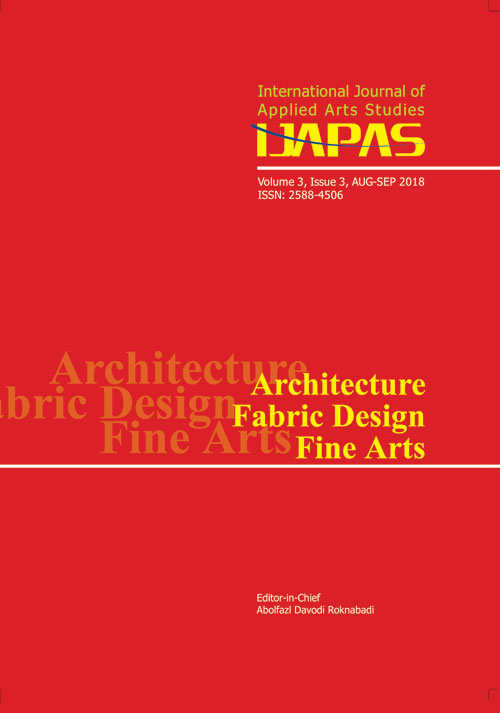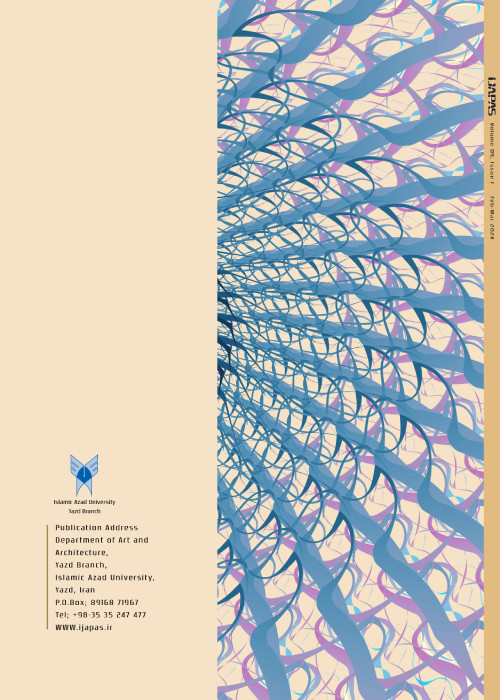فهرست مطالب

International Journal of Applied Arts Studies
Volume:3 Issue: 3, Aug-Sep 2018
- تاریخ انتشار: 1397/10/15
- تعداد عناوین: 6
-
Pages 7-18This paper is concerned with one of the oldest design disciplines i.e. architecture, and one of the newest ones i.e. experience design. It is based on the assumption that as an emerging discipline, experience design may learn much from architecture, while architecture could make itself a new way out with the help of an experience design’s intensive research agenda. It argues that, to mediate both disciplines, a common conceptual and theoretical framework is required. Towards this ultimate aim, first it reviews the essentials of the so-called experience design and related issues of architecture, with a special emphasis on their common epistemological roots, and then it goes on to give a rough sketch of a theoretical and conceptual framework.Keywords: Architectural Design, Experience Design, Design Epistemology, Theory ofArchitecture
-
Pages 19-33Territorial architecture observations reveal the spatial quality hidden in urban neighborhoods, influenced by traditional tissues and Iranian architectural patterns. This paper was to explain these factors from a new perspective. To this end, at the beginning, "Grounded Theory" was used as an emergent and efficient method in the process of qualitative research. Then, Saat Square in Yazd was selected as the case study to explain the stages of this research step-by-step. The data were analyzed with a focus on three stages of coding, axial coding and selective coding. The document analysis method was employed in the open coding process to categorize the concepts, discover the relations among the components and reveal dimensions in the axial and selective coding stages. Finally, based on Strauss and Corbin's ideas, the paradigmatic pattern was organized as follows: 1) Casual variables, 2) Contextual variables, 3) Mediating variables, 4) Axial phenomenon or category, 5) Strategies, and 6) Outcomes. Findings of this research suggested that the overview of physical structure and proper spatial orientation leads to detection of factors such as introversion, the possibility of behavioral variation in space (flexibility), the appearance of religious symbols, physical contradictions, physical proportions, spatial- mental imagination, sense of attachment, spatial stability, reminiscence and nostalgia of a space.Keywords: Memory, Spatial Attachment, Saat Square, Grounded Theory, Social Solidarity, Identity
-
Pages 35-44The industrial ruins (or remains) of every country are the activities and historical achievements that follows motivation to identify and its protection. The expansion of heritage requires database and comprehensive documentation of physical factors, so as to incorporate a particular user with economic efficiency to develop revitalization and satisfaction. In this paper, an attempt is made to address approaches for recreating the industrial heritage as an urban space that can be converted into an appropriate base for various welfare cultural and recreational activities. This makes it possible for cultural policies and provides an industrial complex for active participation for all people. The researcher has made an attempt by influencing the economic, social and environmental dimensions that causes the enhancement of urban life, revitalizing and conserving the industrial heritage in the city of Yazd. This is done through an applied theoretical research and a qualitative and quantitative approach. Among the influencing factors in the land use changes are a set of environmental and demographic factors which are independent variables and have effects on other variables. It is important to note that the land use changes of textile industry at South Park involves changes in the type of land use, changes in the way of distribution, and changes in spatial pattern activities and land use, design and integration of necessary land use for other valuable structures.Keywords: Recreational Cultural Complex, Industrial Heritage, Land Use Change, Urban Identity
-
Pages 45-54With a glance at the sanctity of calligraphy in Islamic art and historic values of the Jame mosque building of Yazd, one feels the need to study and analyze its aesthetic aspects. The study investigates the aesthetic forms of calligraphy in the inscriptions with the word ‘Ali’ in the Jame mosque of Yazd and how the aesthetics of the calligraphy affect the attraction of audience of the mosque in Yazd. Certainly, the efficiency of calligraphy in the inscriptions of the mosque can increase the presence of the audience heart. Therefore, the present research has made an attempt with respect to Islamic rules and Shia religion to study the functions of the word Ali and also to consider its structure and content significance. The results show that there are two important poles in the Islamic visual art, which are architecture and calligraphy. In Islamic architecture, calligraphy has been frequently used which has an indescribable beauty. The calligraphy is effective on the aesthetics of the Jame mosque. Accordingly, the study has been conducted using a descriptiveanalytical method to analyze the aesthetics of the word ‘Ali’ in the tiles of the Jame mosque in Yazd.Keywords: Aesthetics, Calligraphy, Ali, Jame Mosque, Yazd
-
Pages 55-63Hyper-realism style is considered as attractive and meaningful concepts regarding its unique and real advantages. One of the fields that has a manifestation capacity of hyper- realism designs and yet has attracted less attention is textile. This research has focused on designing, painting and printing images on polyester fabrics by using hyper-realism style. It has used polyester fabric as a suitable substrate to print derived designs from hyper-realism designs. It has also used art elements and images to integrate two or more photos. Creative and various designs were printed by designing software such as Photoshop based on realism and concepts of mentioned art style. Hyper-realism designs were treated on fabrics by batik painting and sublimation printing, variously. Regarding the attractive and innovative obtained results, polyester fabric can be used for fields such as clothes, panel and bedside lamp designing. As such, a diverse and different vision will be provided through the mentioned applications. It shows a high potential of derived designs from hyper-realism style and its generalization in different life situations. The results of the research showed that hyper-realism designs were created on polyester fabrics by using common methods such as batik painting and sublimation printing.Keywords: Batik, Hyper-Realisim, Painting, Polyester Fabric, Printing, Sublimation
-
Pages 65-71During the Safavid period, Iranian weavers in cities such as Yazd, Isfahan, Kashan, Rasht, Mashhad, Qom and Tabriz could create the most important and largest centers for silk weaving. In this era, Yazd was known for a special fabric weaving called Dibaj which was woven at times with golden yarns. As there was a high level of competition among countries, Ghiyas-uddin and his family had a great opportunity to achieve beautiful designs during the Safavid period. The aim of this research is to investigate the textile art in the Safavid period and the role of Ghiyas in flourishing this art. This study is based on a descriptive-analytical method, and the data collection has been done through library studies.Keywords: Ghiyas-uddin, Safavid Period, Textile Industry


